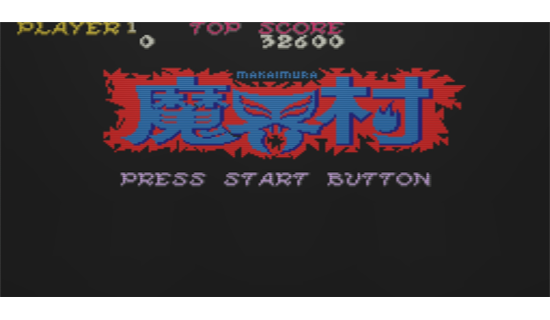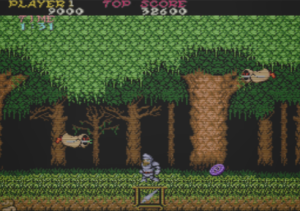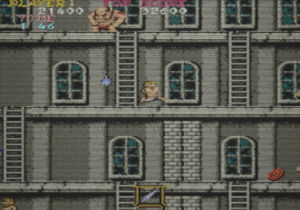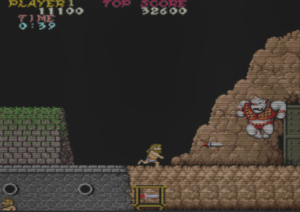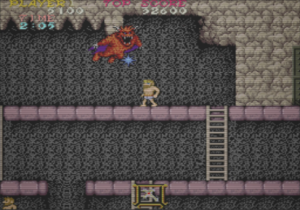“Youkoso irasshai…” (Or “Welcome, come in…”) was the slogan for Makai Mura, a fairly early arcade title by (at the time) young development company Capcom that positively dripped with atmosphere for its time. It drew players in with its dark atmosphere full of monsters and demons, and dirge-y but attractive synthesized organ and keyboard sounds. But these things were all hiding what would become known as one of the most difficult games of that time.
Our valiant knight Arthur sits with a Princess Prin Prin in a romantic graveyard, just having a great time in his underwear with his trusty suit of armor nearby. Suddenly the sky turns dark(er), and Satan himself appears in the sky! He swoops down, grabbing the Princess and knocking Arthur backward, then disappears. Arthur dons his armor and is off to save the Princess, though I don’t think he knows what he’s in for…
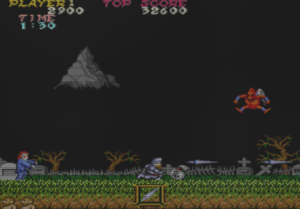
The basic game play is as simple as you would expect from this time: Arthur runs through one of six horizontally scrolling stages throwing his lance (or one of a handful of other weapons that can be helpful in particular situations) at enemies as they appear, and fighting a boss at the end of each stage. But this game, and in fact the entire series that it belongs to, is known for its blistering difficulty. Some still call it one of the most difficult games ever made! Unlike most action platformers, you can’t depend purely on pattern memorization (though that certainly helps a lot) to get you through. There are definitely tricks to get certain enemies to behave the way you want, but I could never get them to work with complete consistency. The best example is controlling the dreaded Red Arremer. My understanding is that it’s mostly done by strategic timing of when you jump up and stand still near him, since the idea is to get him to ground himself do his little dance toward you, since he’s nothing but trouble from the air. I was able to do this with probably about 85% consistency, but that left those times when he wouldn’t behave and I was never really sure why. Spawn locations of other more minor enemies are pretty consistent, things can just get a little hectic in later areas when things are spawning above you from off-screen.
None of this is helped by the fact that Arthur can’t throw his weapons up, down or in any diagonal direction. His jump is also comically short and floaty, which might make some sense given that he’s wearing armor. This makes what few platforming challenges there are much more harrowing than what seem like such simple jumps would otherwise prove to be. There are also some small control issues that you tend to take for granted, even in older games, that just weren’t here. To get out of a crouch you explicitly have to press up or another direction, and when climbing a letter you have to press up to actually get off of the ladder. Fast button pressing is also pretty important, particularly against enemies that will just keep walking at you while you’re damaging them, like the giants who drop rocks on you. Sub weapons can help in these situations, particularly if you have the dagger (the fastest sub weapon).
If you manage to overcome all of this adversity to reach the final boss Astaroth (he was originally called Gondias in Japan, and would have his name changed to Astaroth around 1991), you’ll be sent back to the beginning of the previous stage if you don’t come in with a cross as your weapon. But even if you’re properly equipped for the fight, you’ll still weep with frustration if you win (and you probably will, it’s not a difficult fight). Why? Because you’re quickly informed that this room was an illusion, and a trap set by Satan. What does that mean? It means you’re going to have to play through the entire game again! The difficulty is cranked up slightly, with enemy behavior even less dependable than they were the first time through! This is the true horror of Makai Murai.
Despite the unreasonable difficulty, I’ve always felt a lot of affection of this game from the first time I saw it in an arcade (though I’ll be damned if I can clear it with any kind of consistency). A lot of it has to do with the slightly creepy atmosphere that the graphics and (especially) music provide. A lot of players were probably captured by it in the same way I was as a kid: Frustrated the whole way through, but something about it just kept you coming back to try to see what was next. It’s difficult to recommend now unless you’re someone who’s always in search of challenging old games.
The arcade game itself has a very interesting history of revisions, with several documented versions out there to address specific bug fixes. The most notable though, is a bug that would actually allow the game to loop forever, instead of just twice. And if you can believe it, when they re-released this new version they actually made a couple of things easier in stage 6! Decreasing the number of Unicorns by one, and reducing the amount of hits that Satan could take, etc. America did not get all of these revisions though, which is why (at least as far as I know) there is no American version of the arcade game that doesn’t have two Unicorns in stage 6.
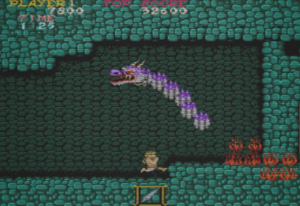
This was a very highly ported game in its time, but given how young most home console and computer hardware was back then, none of the home ports were very much like the arcade version at all. Still, you can play not incredibly accurate ports on the NES/Famicom, WonderSwan (Japan only), Game Boy Color (Western countries only), Game Boy Advance, PC, Commodore 64, Amstrad, ZX Spectrum, PC-8801, FM-7, Amiga, Atari ST, and various mobile platforms. If you’re looking for good ports of the arcade version though, there are some of those to be found as well: Capcom Generations Vol. 2 (released only in Japan on the PlayStation and Saturn) has a good Capcom ported (at least as far as the information I can find) version. The games in the Capcom Generations series would largely be used as a base for the later PlayStation 2/XBox/PSP Capcom Classics Collection (The PSP collection that this game appears on is called Capcom Classics Collection Reloaded outside of Japan). Though I’m not aware of any issues with Makai Mura/Ghosts n Goblins specifically on this collection, there are other games that do have some issues, so this one may not be the best choice. The Wii Virtual Console also got a port of the arcade version in all regions. In my opinion the best choice for playing this is Capcom Arcade Cabinet, a downloadable title found on both PlayStation3 and XBox 360. This collection was ported by M2, the gods of arcade porting themselves. This means there are also a lot of options in terms of how easy or hard you want the game to be, and a lot of unlock-able extras such as art and arcade flyers.
